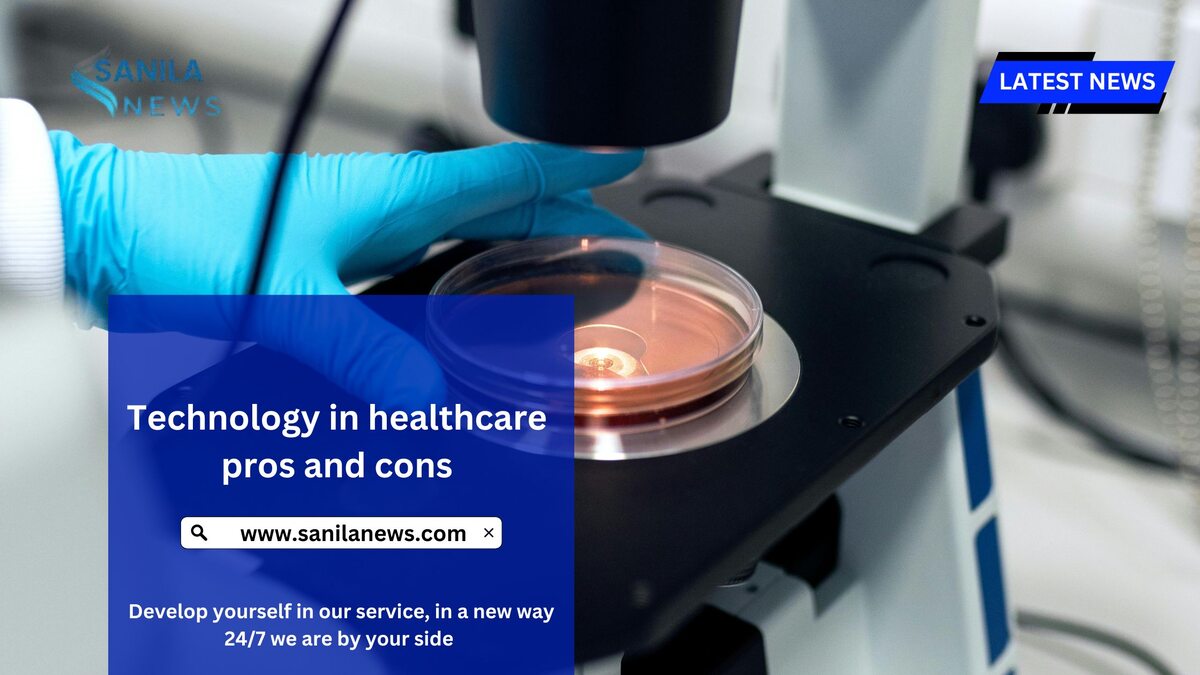Technology in Healthcare Pros and Cons:
Technology in healthcare pros and cons, Technology has revolutionized many sectors, and healthcare is no exception. Over the past few decades, advances in medical technology have transformed the way healthcare is delivered, improving both access to care and patient outcomes. From telemedicine to robotic surgery, and electronic health records (EHR) to artificial intelligence (AI)-driven diagnostics, technology continues to change the landscape of healthcare. However, while these innovations offer significant benefits, they also come with their share of challenges.
In this article, we will explore the pros and cons of technology in healthcare, examining its impact on patient care, healthcare providers, and the broader medical system.
Technology in healthcare pros and cons:
The Pros of Technology in Healthcare
- Improved Diagnosis and Treatment Accuracy
One of the most significant advantages of technology in healthcare is the improvement in diagnostic and treatment capabilities. Advanced imaging techniques such as MRI, CT scans, and ultrasound provide detailed, high-resolution images that enable physicians to identify conditions earlier and with greater precision. Similarly, AI-powered diagnostic tools, such as algorithms that detect patterns in radiology scans or pathology slides, have shown promise in identifying diseases like cancer at earlier stages. These technologies can also help in providing personalized treatment plans based on genetic or molecular data.
Example: AI systems can analyze complex data sets from medical images, lab results, and patient histories to identify conditions like diabetic retinopathy or even predict potential heart attacks. This leads to quicker and more accurate diagnoses, reducing the likelihood of human error. - Enhanced Patient Monitoring
Wearable devices and mobile health apps are revolutionizing how patients monitor their health and interact with their healthcare providers. Devices like smartwatches and fitness trackers can monitor vital signs such as heart rate, blood pressure, and blood sugar levels, providing real-time data to both patients and clinicians. This enables proactive management of chronic conditions such as diabetes, hypertension, and heart disease.
Example: Continuous glucose monitors (CGMs) allow diabetic patients to monitor their blood sugar levels in real-time, reducing the need for finger-prick tests and enabling better glycemic control. The data can be shared with healthcare providers, allowing for adjustments in treatment without the need for frequent in-person visits. - Telemedicine and Remote Care
Telemedicine has grown exponentially in recent years, especially during the COVID-19 pandemic. It allows patients to consult healthcare professionals remotely, reducing the need for physical visits to hospitals or clinics. This is especially beneficial for individuals living in rural or underserved areas where access to medical facilities may be limited. Telemedicine also increases convenience for patients who can receive care from the comfort of their homes.
Example: Telepsychiatry has become an effective means of providing mental health services, enabling patients to access therapy or counseling sessions remotely. This reduces barriers to care, such as stigma or transportation issues, and allows for more frequent follow-ups. - Robotic Surgery and Minimally Invasive Procedures
Robotic-assisted surgeries and minimally invasive techniques have transformed many surgical procedures. These technologies allow surgeons to perform operations with greater precision, smaller incisions, and less risk of complications. Patients benefit from reduced recovery times, less pain, and shorter hospital stays.
Example: The da Vinci Surgical System is widely used for procedures such as prostatectomies, hysterectomies, and cardiac valve repairs. Surgeons can control robotic arms equipped with surgical instruments, which offer greater flexibility and precision than traditional surgical tools. - Electronic Health Records (EHRs)
The digitization of health records has streamlined healthcare administration and improved the continuity of care. EHRs provide healthcare professionals with easy access to a patient’s medical history, lab results, imaging studies, and treatment plans. This enhances collaboration among healthcare providers, reduces redundant testing, and minimizes the risk of errors caused by incomplete or incorrect information.
Example: In emergency situations, EHRs allow doctors to quickly access a patient’s history, including allergies, medications, and past treatments. This can be critical in ensuring timely and appropriate interventions. - Artificial Intelligence and Machine Learning
AI and machine learning (ML) technologies are increasingly being integrated into healthcare. These systems can process large amounts of data to identify patterns, make predictions, and assist in decision-making. AI is being used in various fields, including radiology, pathology, and genomics, to improve diagnostic accuracy and personalize treatment.
Example: IBM’s Watson for Oncology uses AI to help oncologists make informed treatment decisions by analyzing a patient’s medical data in conjunction with the latest research findings. This system can recommend the most effective treatment options based on the individual characteristics of the patient’s cancer. - Pharmaceutical Development and Personalized Medicine
Technology has accelerated the process of drug discovery and development. Machine learning algorithms are used to identify potential drug candidates, analyze clinical trial data, and even predict how patients will respond to certain medications. Additionally, advancements in genomics have enabled personalized medicine, where treatments can be tailored to an individual’s genetic makeup.
Example: Gene-editing technologies such as CRISPR hold the promise of treating genetic disorders at their source, potentially curing diseases like cystic fibrosis or sickle cell anemia by editing the faulty genes responsible for these conditions.
Technology in healthcare pros and cons:
The Cons of Technology in Healthcare
- High Costs
While technology can improve care, it often comes with a hefty price tag. The development, implementation, and maintenance of advanced healthcare technologies require substantial financial investment. Hospitals and clinics may need to purchase expensive equipment, train staff, and continuously upgrade systems to keep up with technological advancements.
Example: Robotic surgery systems like the da Vinci Surgical System can cost millions of dollars, with additional expenses for maintenance, training, and disposable instruments. These costs are often passed on to patients, contributing to the rising cost of healthcare. - Privacy and Security Concerns
The digitization of health records and the use of connected devices raise significant privacy and security concerns. Healthcare data is a prime target for cyberattacks, as it contains sensitive personal and medical information. Data breaches can lead to identity theft, financial loss, and compromised patient safety.
Example: In 2020, a major healthcare provider experienced a data breach that exposed the personal information of millions of patients, including medical histories, Social Security numbers, and financial details. Such incidents highlight the need for robust cybersecurity measures in healthcare. - Increased Reliance on Technology in healthcare pros and cons
While technology can enhance care, it can also lead to over-reliance on machines and automated systems. Physicians and other healthcare professionals may become too dependent on AI or diagnostic tools, potentially reducing their clinical judgment and critical thinking skills. Additionally, when systems fail or malfunction, the quality of care may be compromised.
Technology in healthcare pros and cons example: In some cases, healthcare providers may rely heavily on AI algorithms for diagnostic decisions without fully understanding the underlying mechanisms. If the AI system provides incorrect recommendations, patient care could be jeopardized. - Limited Access in Low-Resource Settings
While telemedicine and digital health tools have expanded access to care in many areas, they are often inaccessible in low-resource settings. Rural or underdeveloped regions may lack the necessary infrastructure, such as reliable internet access, to support these technologies. Additionally, the high costs of advanced medical technologies can prevent their adoption in low-income countries or underserved communities.
Example: In some parts of the world, hospitals may not have the resources to implement EHR systems or invest in high-tech diagnostic equipment. As a result, healthcare in these areas remains reliant on paper records and traditional diagnostic methods. -
Job Displacement and Workforce Challenges
The increasing automation of healthcare tasks, such as diagnostics and administrative functions, raises concerns about job displacement. As AI and robotic systems take over certain roles traditionally performed by humans, healthcare professionals may find their jobs at risk. Additionally, the integration of new technologies requires ongoing training and education, which can be a burden for healthcare workers.
Example: AI-driven diagnostic tools may reduce the demand for radiologists or pathologists in the future, as algorithms become more proficient at analyzing medical images and lab results. Similarly, the automation of administrative tasks, such as appointment scheduling or billing, could lead to job losses in healthcare administration. - Ethical and Legal Challenges
The use of AI, robotics, and other advanced technologies in healthcare raises complex ethical and legal questions. For example, who is responsible if an AI system makes an incorrect diagnosis that leads to harm? How should healthcare providers balance the use of AI with human judgment? There are also concerns about the fairness and transparency of AI algorithms, particularly if they perpetuate biases present in the data they are trained on.
Example: A study found that certain AI algorithms used in healthcare were less accurate in diagnosing conditions in patients of certain ethnic backgrounds due to biased training data. This highlights the potential for AI to exacerbate existing healthcare disparities if not properly managed. - Technological Burnout and Physician-Patient Disconnect
The introduction of new technologies can sometimes increase the administrative burden on healthcare providers. For example, the use of EHRs has been associated with increased documentation requirements, leading to physician burnout. Additionally, the reliance on technology during patient interactions may reduce the quality of communication and the doctor-patient relationship.
Example: Physicians may spend more time entering data into EHR systems than engaging with patients during consultations. This can lead to a sense of disconnect, where patients feel they are not receiving the personal attention they need.
Balancing the Pros and Cons
Technology in healthcare presents a complex landscape of opportunities and challenges. While it offers immense potential to improve patient outcomes, enhance diagnostic accuracy, and increase access to care, it also comes with risks related to cost, privacy, and workforce disruptions. To fully realize the benefits of healthcare technology, it is essential to strike a balance between innovation and careful management of its drawbacks.
Healthcare providers, policymakers, and technology developers must work together to ensure that
Last word
Keep an eye on our news channel Sanila News to get updated news regularly.

